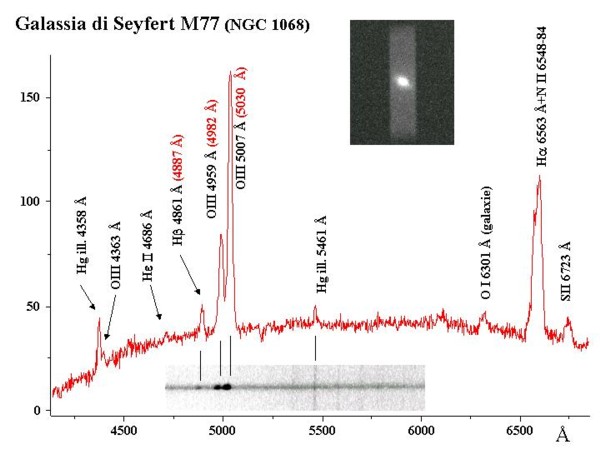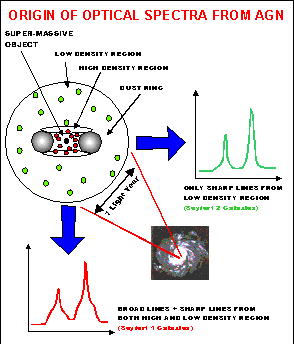EXTRAGALACTIC OBJECTS SPECTRA
Galaxies
- Seyfert
- Quasars
Seyfert galaxies spectra
Around 1943 the astronomer Carl K. Seyfert found that a dozen of galaxies show a particularly bright nucleus
(with stellar or quasi-stellar central condensation) with an emission line spectrum.
The high condensation of light around nucleus and into the few emission lines (picture 1) make these object
quite easy for recording the spectrum, despite the fact that they are all quite faint. Infact a first spectrum
of a Seyfert galaxy had been recorded as early as 1908 by Edward A. Fath at the Lick observatory.
Seyfert galaxies belong to the family of galaxies with active nucleus (AGN). Peculiar visible spectra, and often
strong X and radio emission, from these objects do not originate from stars but are caused by a central
supermassive (black hole?) object accumulating gaseous matter from the surrounding galaxy.
Differemces among AGNs are probably due only to the different viewing angle and the amount of matter falling
into it.
Subclasses of AGN galaxies are: Radio loud galaxy with sharp lines, Radio loud galaxy with broad lines,
Blazars (with emission lines that appear only when the continuum weakens), Seyfert 1, Seyfert 2,
galaxies BL Lac (with both broad and sharp lines),QSO (quasars without radio emission) and
Quasars.
Seyfert 2 galaxies show only sharp lines while Seyfert 1 show also broad permitted lines (that is to say,
mainly Balmer series) together with sharp permitted an forbidden lines.
The picture number 1 shows the visible spectrum that we recorded for M77 that is a type 2 Seyfert galaxy.

|
Picture 1: Spectrum of the central part of M77, the brightest of Seyfert galaxies (mv=8.9) in Cetus.
In the upper right box can be seen the bright nucleus of M77 throught the wide opened slit (45 arc sec
wide and 3' height) recorded at zero order with 30 seconds exposure.
The spectrum has been recorded with the slit closed at 200 mm, equivalent to 4" on the sky, with an exposure
time of 3X5 minutes on a Xpress MX5 CCD (14 January 2003). Spectral resolution is about 7 ┼.
Wavelength of lines are written in black for the rest frame. Poistions marked in red color are measured
in the spectrum calibrated with sky background lines. It can be seen that lines belonging to M77 are shifted to the red of roughly 20 ┼ because of cosmological red shift at a distance of 60 million light years.
|
Seyfert 1 galaxies show a gradual increase of broad lines strenght thus they are classified with intermediate numbers.
As an example, NGC 4051 in Uma (the second brightest Seyfert galaxy with mv=10.2) is classified as Seyfert 1.5.
There is a theory that explains quite well a lot of phenomena observed for the Seyfert galaxies and suppose the presence
of a supermassive object in the center of the galaxy. Close to this object we find a region of high density gas
surrounded by an opaque accretion disk, and then a region of low pressure gas.
Sharp forbidden lines arise from the low density external region that behaves like HII diffuse
nebulae while the broad (and often variable) lines comes from the small (1 light year across) inner region
with high density.

|
Picture 2: Explanation of different optical emission from Seyfert 1 and 2 galaxies.
Differences among the two types may be only due to a different orientation of the source respect to the
observer. In type 2 Seyfert galaxies (like in M77) a dust ring hide the high density core and thus the broad permitted lines
are no more visible.
|
Goto other extragalactic objects:
Normal Galaxies
- Quasars
|
|


